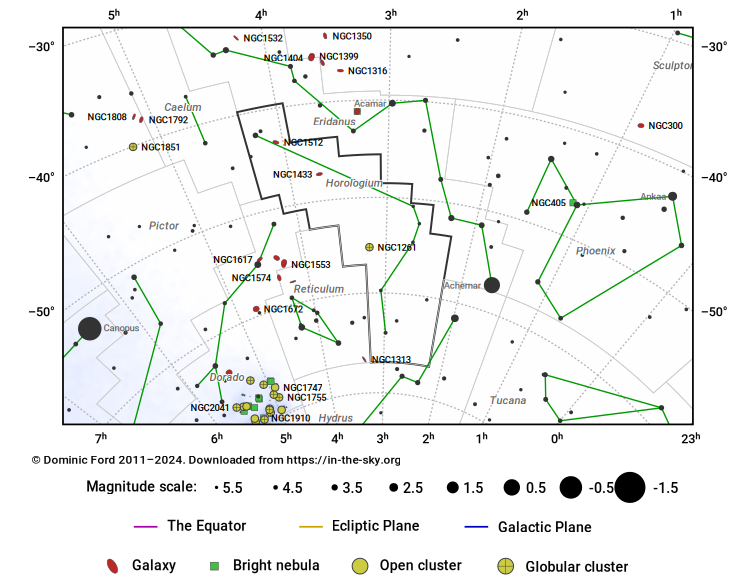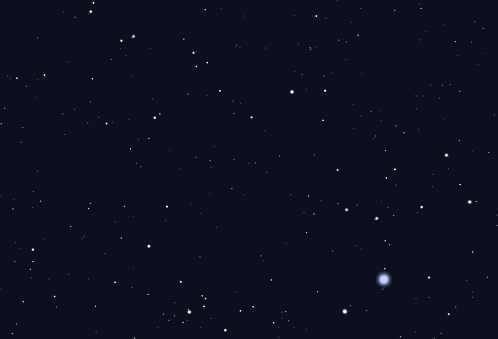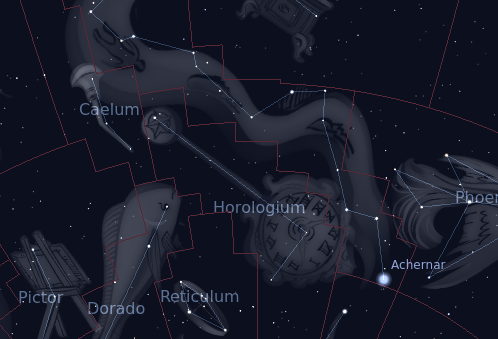The Constellation Horologium
Horologium is a small southern constellation which culminates at around midnight in November.
The name ‘Horologium’ is Latin for ‘clock’, and the constellation is usually depicted as a pendulum clock. The name was assigned to this sky area by Nicolas Louis de Lacaille in 1756.
Horologium has only two stars brighter than fifth magnitude, but does have a few deep sky objects of interest, including the globular cluster NGC 1261 and the barred spiral galaxy NGC 1512.
A very much more challenging cluster is Arp-Madore 1, the most distant known globular cluster in orbit around the Milky Way. However, at magnitude 16, a large telescope is needed to see it.
1756 (Lacaille)
0.6% of the sky
248.9 square degrees
Horologium contains no Messier objects
Hover the pointer over the name of an object to highlight its position on the starchart to the right, or click to see more information.
| Stars | Open Clusters | Globular Clusters | Galaxies |
| α-Hor (mag 3.9) | NGC 1252 | NGC 1261 (mag 8.4) | NGC 1433 (mag 9.9) |
| δ-Hor (mag 4.9) | NGC 1512 (mag 10.4) | ||
| β-Hor (mag 5.0) | NGC 1527 (mag 10.8) | ||
| μ-Hor (mag 5.1) | NGC 1448 (mag 10.9) | ||
| ζ-Hor (mag 5.2) | NGC 1411 (mag 11.2) | ||
| ν-Hor (mag 5.3) | NGC 1493 (mag 11.4) | ||
| η-Hor (mag 5.3) | IC 1954 (mag 11.6) | ||
| HIP 20161 (mag 5.3) | IC 2035 (mag 11.8) | ||
| λ-Hor (mag 5.4) | NGC 1249 (mag 11.8) | ||
| ι-Hor (mag 5.4) | NGC 1494 (mag 11.9) | ||
| HIP 16509 (mag 5.7) | IC 2000 (mag 12.4) | ||
| HIP 17534 (mag 5.7) | IC 1970 (mag 12.4) | ||
| γ-Hor (mag 5.8) | NGC 1031 (mag 12.5) | ||
| TW Hor (mag 5.8) | IC 1933 (mag 12.6) | ||
| HIP 10871 (mag 5.8) | NGC 1495 (mag 12.6) | ||
| HIP 15305 (mag 5.8) | NGC 1483 (mag 12.8) | ||
| HIP 18199 (mag 5.9) | NGC 1096 (mag 12.8) | ||
| TU Hor (mag 6.0) | IC 1959 (mag 12.8) | ||
| HIP 13387 (mag 6.0) | NGC 1311 (mag 12.9) | ||
| HIP 14749 (mag 6.1) | NGC 1136 (mag 13.0) | ||
| HIP 12775 (mag 6.2) | NGC 1510 (mag 13.0) | ||
| HIP 13518 (mag 6.2) | IC 1914 (mag 13.0) | ||
| HIP 11925 (mag 6.3) | NGC 1356 (mag 13.1) | ||
| HIP 12717 (mag 6.3) | IC 1949 (mag 13.2) | ||
| HIP 11479 (mag 6.3) | NGC 1025 (mag 13.4) | ||
| HIP 19721 (mag 6.4) | NGC 1476 (mag 13.8) | ||
| HIP 15655 (mag 6.4) | NGC 1246 (mag 13.9) | ||
| TZ Hor (mag 6.4) | NGC 1244 (mag 13.9) | ||
| HIP 17493 (mag 6.5) | IC 1908 (mag 14.1) | ||
| HIP 12389 (mag 6.5) | IC 1929 (mag 14.2) |




